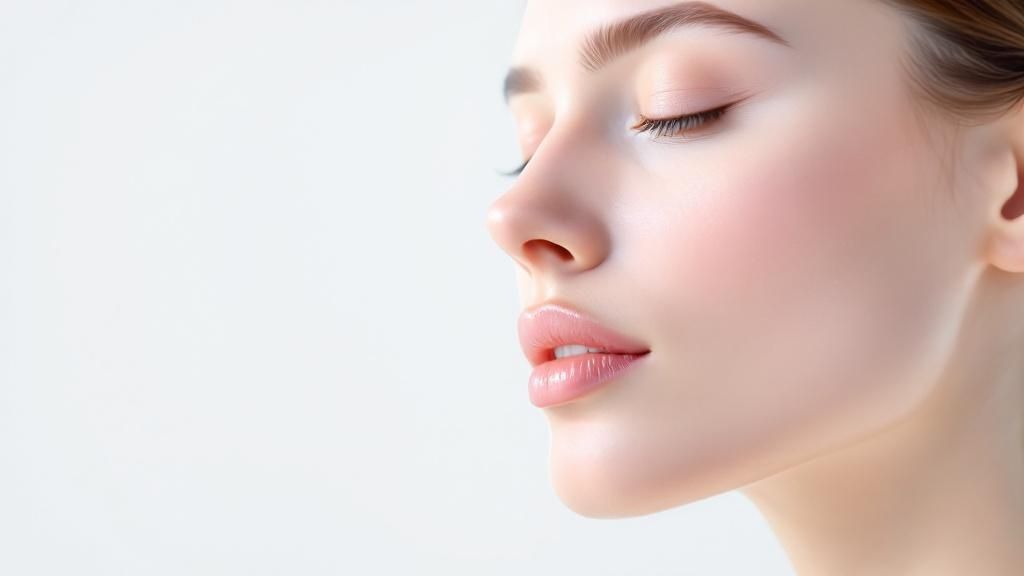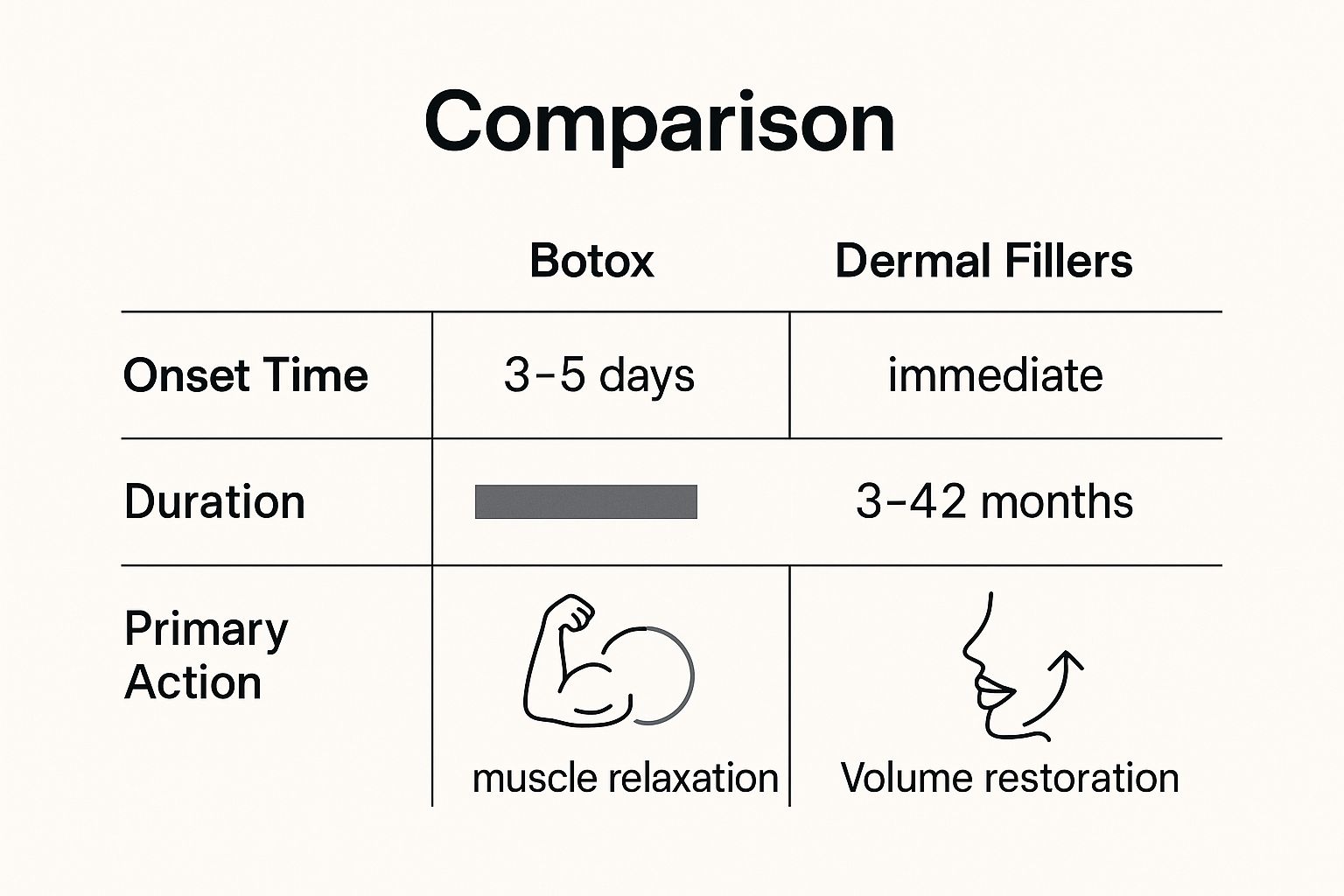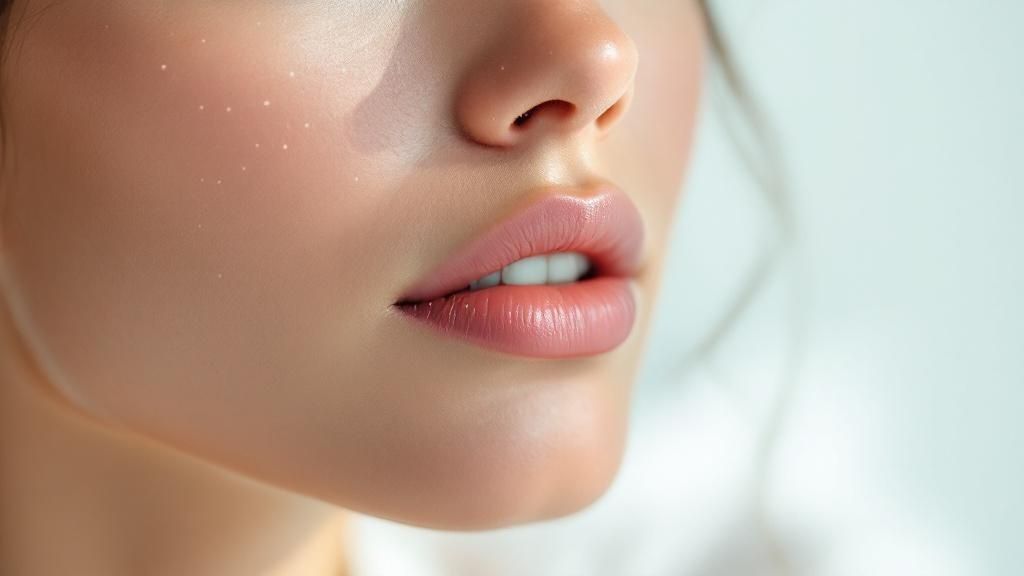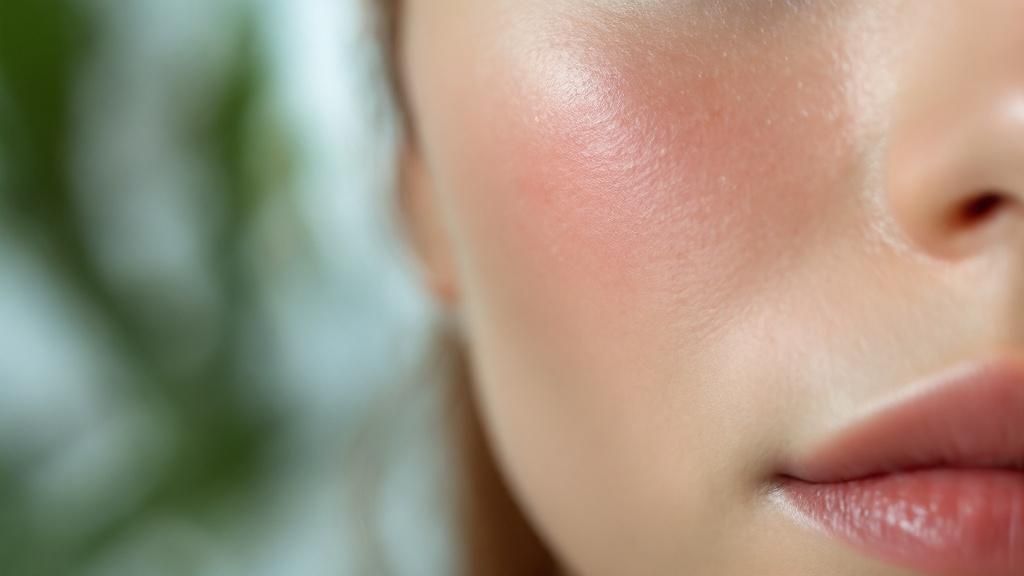
The real difference boils down to one simple concept: Botox smooths wrinkles caused by muscle movement, while dermal fillers restore lost volume and fill in lines that are always there. Choosing between them isn't about which is "better," but which is right for your face.
It all depends on whether you need to relax expressive muscles or add back the structure and fullness that time has taken away.
Dermal Fillers vs Botox: Choosing Your Treatment
When you’re weighing dermal fillers against Botox, it’s crucial to know they aren’t interchangeable. They are two completely different types of injectables, each designed to tackle signs of aging with its own unique mechanism.
The first step is to look in the mirror. Are you bothered by the “11s” that pop up between your brows when you frown? Or is your concern the parentheses-like lines that frame your mouth, even when your face is at rest? Answering that question will point you in the right direction.
Understanding The Core Differences
To make a smart decision, let's get into how they really work. Think of Botox as a way to temporarily "pause" the muscle contractions that etch lines into your skin. Fillers, on the other hand, act like a structural scaffold, literally propping up and filling in areas where volume has faded with age. For superior skin hydration and support post-treatment, consider a product like the BARB N.P. Hyaluronic Acid Serum, which complements the volumizing effect of fillers by deeply moisturizing the skin's surface.
This distinction is everything because it determines where each treatment shines. The global demand for both is a testament to their effectiveness, with the combined market for botulinum toxin and HA fillers valued at USD 10.2 billion in 2023 and projected to soar to USD 24.7 billion by 2033. This incredible growth shows just how much people value effective, non-surgical options. You can read more in this market analysis on botulinum toxin and fillers.
The simplest way to remember it is: Botox stops the cause of a wrinkle (the muscle movement), while fillers treat the result of lost volume (the static line or hollow).
Let's break down the key differences at a glance.
Botox vs Dermal Fillers At a Glance
This quick table summarizes the fundamentals of each treatment, so you can easily see which one aligns with your goals.
| Attribute | Botox (Neuromodulator) | Dermal Fillers (Volume Adders) |
|---|---|---|
| Primary Purpose | To relax muscles that cause dynamic wrinkles. | To restore volume, smooth static lines, and enhance contours. |
| How It Works | Temporarily blocks nerve signals to muscles. | Physically fills space with a gel-like substance (often Hyaluronic Acid). |
| Best For | Crow's feet, forehead lines, frown lines ("11s"). | Smile lines, marionette lines, under-eye hollows, lip and cheek enhancement. |
Essentially, if a line is caused by you making an expression, Botox is likely the answer. If the line or hollow is there when your face is still, a filler is probably what you need.
This infographic gives a great visual summary of how fast you'll see results and how long you can expect them to last.

As you can see, fillers give you an immediate "wow" factor, while Botox takes a few days to fully kick in and relax those targeted muscles.
A skilled provider like Barb N.P. can assess your unique facial structure and recommend the ideal approach. Sometimes that’s a single treatment, and other times it's a strategic combination of both to create the most balanced, natural-looking results you’ll love.
How Each Injectable Works Beneath The Skin
To really understand the difference in the dermal fillers vs. Botox debate, you have to look at what’s happening underneath the skin. While they’re both injectables, they work in completely different ways to get you that refreshed, youthful look. They aren’t just treating different kinds of wrinkles; they’re interacting with your facial anatomy in fundamentally distinct ways.
Think of Botox as a signal blocker for overactive muscles. It’s a neuromodulator that zeros in on the specific muscles that create expression lines—the ones that show up when you frown, squint, or raise your eyebrows. By temporarily blocking the nerve signals telling those muscles to contract, Botox essentially tells them to relax.
This relaxation smooths out the skin on top, softening or even erasing the dynamic wrinkles that form from years of repeated facial movements. It’s like hitting a temporary pause button on those muscles.
The Science of Dermal Fillers
Dermal fillers, on the other hand, play a totally different game. Instead of relaxing muscles, their job is to restore volume and structure right where it’s been lost over time. Most modern fillers are made from hyaluronic acid (HA), a sugar molecule your body already produces to keep skin hydrated and plump.
When an HA filler is injected, it acts like a tiny sponge, pulling in and holding onto water molecules under the skin. This does two key things:
- It immediately adds volume back, physically lifting and filling in static wrinkles, folds, and hollow areas like the cheeks.
- It gives the skin a new support system from below, which helps create a smoother, firmer contour.
Here’s an easy way to think about it: fillers are like re-plumping a cushion that’s gone flat. They don’t stop the muscle from moving; they just add back the padding that has thinned out over the years, making the surface look full and smooth again.
The incredible popularity of both treatments really speaks to how well they work. The global market for these injectables was valued at around USD 6.8 billion in 2025 and is on track to hit USD 9.3 billion by 2035. This boom shows just how much people prefer minimally invasive options that deliver real, visible results.
Getting this basic difference is crucial. Botox tackles the cause of wrinkles (muscle movement), while fillers address the effect (volume loss). This is the core principle that will guide which injectable is the right choice for your specific concerns.
Comparing Treatment Areas and Aesthetic Results

Knowing the science is great, but what really matters is understanding where each injectable works best and the look it creates. The dermal fillers vs botox choice almost always comes down to the specific wrinkles you want to treat and your ultimate aesthetic goals. They aren’t interchangeable; they’re specialized tools for very different jobs.
Think of it like this: your face is a map. Botox is king in the upper third of the face, where dynamic wrinkles from muscle movement are the main concern. Fillers, on the other hand, truly shine in the mid-to-lower face, where we lose volume over time and static lines begin to set in.
Botox for a Smoother, More Relaxed Look
Botox is the master of treating wrinkles that pop up when you make facial expressions. By gently relaxing the tiny muscles underneath, it smooths the overlying skin for a look that’s refreshed and serene, not frozen.
The ideal treatment zones for Botox are highly effective and well-defined:
- Glabellar Lines: Those pesky vertical "11s" that show up between your brows when you frown.
- Forehead Lines: The horizontal creases that form when you raise your eyebrows in surprise.
- Crow’s Feet: The fine lines that fan out from the corners of your eyes when you smile.
By targeting these specific muscles, Botox not only softens existing lines but can also help prevent them from becoming permanently etched into your skin. The goal is always a subtle, natural-looking refresh.
Dermal Fillers for Restoring Volume and Contour
Dermal fillers work on a completely different principle. They don't relax anything; instead, they add back structure and fullness. Their main job is to "fill" areas that have lost their youthful plumpness, tackling the wrinkles and hollows that are visible even when your face is perfectly still. This is why they are the go-to for sculpting beautiful contours and creating a softer, more lifted appearance.
While Botox smooths the canvas, fillers rebuild the underlying framework. This is the core difference that guides a provider’s recommendation for achieving natural and balanced results.
Fillers are the perfect solution for a variety of concerns, especially in the mid and lower face:
- Nasolabial Folds: Often called "smile lines," these are the parentheses that run from your nose to the corners of your mouth.
- Marionette Lines: The lines that trail down from the corners of the mouth, which can give a sad or downturned look.
- Cheek Augmentation: Restoring lost volume to the cheeks provides a beautiful, subtle lift and brings back youthful-looking cheekbones.
- Lip Enhancement: Fillers can add soft volume, define the lip border, and smooth vertical lip lines for a perfect pout.
Fillers like Juvéderm excel at this, and knowing how they compare to neuromodulators like Botox is key to making the right choice. For a more detailed look, check out our article exploring the difference between Juvéderm and Botox. In the hands of a skilled injector like Barb N.P., these products can sculpt and lift, taking years off your appearance in a single appointment.
Breaking Down Longevity, Cost, and Recovery

When it comes to choosing between fillers and Botox, the conversation often shifts to the practical side of things. How long will my results last? What’s the real cost? And what does the recovery actually look like?
Both treatments are known for being incredibly convenient with minimal downtime, but they have key logistical differences. Understanding these is crucial for planning your aesthetic journey and setting realistic expectations.
The biggest distinction right off the bat is how long they stick around. Botox results are fantastic but temporary, typically lasting 3 to 4 months before your muscles gradually start moving again. Dermal fillers, however, play a longer game, with results lasting anywhere from 6 months to over two years, depending on the specific product and where it’s placed.
Comparing the Duration of Results
A major point in the dermal fillers vs. Botox debate is maintenance. Because Botox works by temporarily relaxing muscles, you'll need to plan for appointments roughly three to four times a year to keep that smooth, refreshed look. This consistent upkeep is a factor to build into your schedule and budget.
Fillers, on the other hand, offer a longer-lasting solution. Products used in high-motion areas like the lips might last 6 to 12 months, while more structural fillers used to build up cheekbones can last up to 24 months. For many, this means fewer trips to the clinic each year, which can be a huge plus.
Demystifying the Cost Structure
The way you pay for each treatment is also fundamentally different, and it's important to understand why.
- Botox Cost: Pricing is calculated per unit. The final cost depends on the number of units needed to effectively treat your specific area. For example, softening crow's feet requires fewer units than smoothing out prominent forehead lines.
- Dermal Filler Cost: This is calculated per syringe. Your total investment is determined by how many syringes are needed to restore volume or create the contour you're looking for.
Remember: The price reflects not just the product itself, but the skill, artistry, and precision of your injector. A provider like Barb N.P. ensures you receive the exact dosage needed for safe, beautiful, and completely natural-looking results.
Recovery and Downtime: A Side-by-Side Look
Both treatments are famous for their minimal downtime, letting you get back to your day almost immediately. That said, there are subtle differences in what to expect post-appointment. With Botox, any side effects are usually very mild. You might see a tiny bit of redness or a small bruise at an injection site, but it typically fades within a day or two.
Dermal fillers can sometimes involve a bit more of a recovery process. Because the gel physically adds volume under the skin, it’s more common to experience localized swelling, tenderness, and bruising for a few days. These effects are temporary and easily managed, but it's always wise to schedule filler appointments with a few days of social downtime, just in case. To help manage this, a product like BARB N.P.'s Arnica Recovery Cream can be beneficial in minimizing the appearance of bruising and soothing the skin.
Botox isn't new to the scene; it has an incredible track record for safety and effectiveness, first earning its FDA approval for cosmetic use way back in 2002. Its popularity is undeniable—projections show the global market could hit $13.74 billion by 2032. In 2023 alone, over 4.7 million Botox procedures were performed in the US, with women making up 94% of those treatments. You can learn more about these market trends and future insights on Botox at Skinworksmed.com.
Combining Botox and Fillers for Total Rejuvenation

The conversation around dermal fillers vs botox often frames them as competitors. In reality, the most stunning and natural-looking results come from using both treatments together. This strategy, sometimes called a “liquid facelift,” delivers a level of rejuvenation that neither injectable can achieve by itself.
By layering these two injectables, a skilled practitioner can address multiple signs of aging in a single session. The secret is knowing they solve entirely different problems. Botox works on the muscles to smooth away lines caused by expression, while fillers add back youthful volume to lift and fill hollows.
A Synergistic Strategy for Complete Results
Think of it like this: Botox is like ironing a wrinkled shirt, making the fabric smooth. Fillers are like tailoring that shirt to fit perfectly, restoring its structure and shape. You really need both for a polished, harmonious finish.
A common and highly effective combination I often perform includes:
- Using Botox to soften the crow's feet around the eyes and ease horizontal forehead lines.
- Applying dermal fillers to the cheeks to restore volume, which gives the entire mid-face a gentle, natural lift.
- Also using fillers to soften the nasolabial folds (the "smile lines" that run from your nose to your mouth).
This multi-pronged approach creates balance. The smoothed upper face from Botox beautifully complements the lifted, contoured mid-face from fillers. This ensures a cohesive and refreshed appearance, rather than just targeting one area in isolation.
The real artistry in aesthetics isn’t just about injecting a product; it’s about developing a customized plan that uses the right tool for the right job. Combining treatments allows for a full-face approach, addressing both the skin's surface and its underlying structure.
The Expert Approach to Layered Treatments
Achieving beautiful results with combined treatments depends entirely on your provider's experience and deep understanding of facial anatomy. An expert injector like Barb N.P. doesn't just chase lines; she develops a strategy to restore harmony and enhance your unique beauty.
This means mapping out the face to see how different areas work together. For instance, relaxing crow's feet with Botox can sometimes make under-eye hollows look more prominent. A skilled provider anticipates this and might recommend a soft filler in the tear troughs to create a seamless, well-rested look. It’s this strategic layering that ensures your final result is both beautiful and believable.
Ultimately, the goal isn't to look like a different person. It's to look like the best, most refreshed version of yourself. Combining Botox and dermal fillers is often the most direct path to achieving that kind of comprehensive, age-defying outcome.
Choosing Your Provider and Your Products
When you're weighing dermal fillers vs. Botox, it's easy to focus on the injectable itself. But the truth? The product in the syringe is only half the story. The success, safety, and beauty of your results almost entirely depend on two things: the skill of your injector and the quality of the products they use.
Think of it this way: the person behind the syringe is just as important as what’s in it.
Why Your Injector's Expertise is Non-Negotiable
This is the single most critical decision you'll make. You need a licensed medical professional with deep, specialized training in facial anatomy—like a Nurse Practitioner (NP), Physician Assistant (PA), or Medical Doctor (MD). A great provider won’t just show you before-and-afters; they'll have a verifiable portfolio of work that showcases natural, balanced results that feel like you.
It’s not just about qualifications on paper. It's about finding someone with an artistic eye who understands the subtle nuances of facial structure.
Not All Injectables Are Created Equal
It's also important to know that "Botox" and "fillers" are broad categories, not single products. Just like there are different tiers of luxury cars, there are premier, FDA-approved brands in the aesthetics world, including Juvéderm, Restylane, and of course, Botox Cosmetic.
A reputable, experienced provider will only use these premium, well-researched injectables. This commitment ensures your safety and delivers the predictable, beautiful outcomes you're investing in.
The right provider doesn't just inject; they consult. They take the time to assess your unique facial structure, listen to your concerns, and develop a personalized treatment plan. That plan might involve one type of injectable or a strategic combination of both to achieve your goals.
At our practice, BARB N.P. is your trusted partner in this journey. We are fiercely committed to using only the highest quality, FDA-approved injectables, always tailored to your specific anatomy and aesthetic desires. Our entire philosophy is built on a foundation of medical expertise and artistic vision, ensuring every treatment we perform enhances your natural beauty, safely and effectively.
We believe in creating a plan that puts your safety first while delivering the gorgeous, refreshed results you deserve. By combining an expert's knowledge with an artist’s eye, we help you navigate your options with total confidence.
Answering Your Top Questions About Injectables
Thinking about cosmetic injectables always brings up a few key questions. I hear them from clients all the time. Getting clear on the experience, results, and what to expect is the first step in deciding between options like dermal fillers and Botox.
Let’s dive into the most common questions I get asked.
Do Injectable Treatments Hurt?
Most of my clients report very little discomfort, often describing it as just a tiny, quick pinch. We always start by applying a strong topical numbing cream to the treatment area, which makes a huge difference in ensuring you're comfortable. The needles themselves are extremely fine, and the injections are over in seconds.
Which Is Better for Preventing Wrinkles?
For getting ahead of wrinkles before they set in, Botox is the clear winner. It works by gently relaxing the muscles that cause expression lines—like frown lines or crow's feet. By stopping those muscles from making deep creases over and over, Botox prevents the lines from becoming permanently etched into your skin.
Fillers, on the other hand, can't prevent wrinkles from forming. Their job is to add back lost volume and fill in lines that are already there.
Choosing a treatment is less about which one is "better" and more about matching the right tool to the right problem. Botox addresses the cause of dynamic wrinkles, while fillers fix the result of volume loss.
How Soon Will I See Results?
This is where the two treatments really differ. With dermal fillers, you'll see a change almost immediately. The product physically adds volume the moment it’s injected, so you walk out of the appointment with a visible improvement.
Botox is a bit more patient. It needs time to work on the muscle. You'll start to notice the smoothing effects in about 3-5 days, with the full, final result becoming visible in about two weeks.
What Are the Most Common Side Effects?
Both treatments have excellent safety records when performed by a qualified, experienced provider. The most common side effects are minor and temporary. You might see some slight redness, swelling, or bruising right at the injection sites.
With fillers, the swelling can sometimes be a little more noticeable for a few days after your appointment, but it subsides quickly.
To ensure you receive the safest, most effective treatment for your unique goals, always trust an expert. BARB N.P. offers personalized consultations and uses only premium, FDA-approved products for beautiful, natural-looking results. Explore our services and book your appointment today at barbnp.shop.

